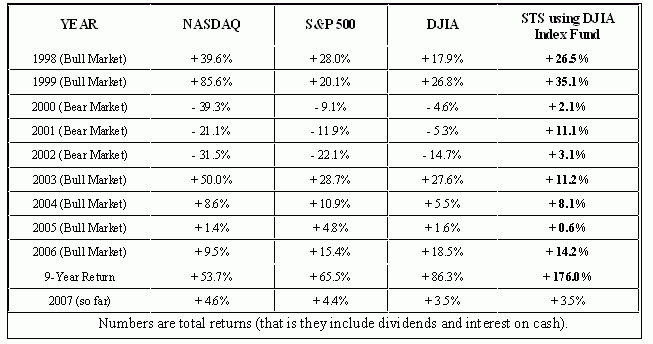___________________
Sy Harding
HOW LONG WILL THE FORCE BE WITH US? April 20, 2007.
It’s that time of year to remind you again of the market’s annual seasonality.
In both bull and bear markets, in almost every year, the market makes most of its gains in a four to seven month period in the fall and winter months.
There is a powerful and consistent force that produces that pattern, and that force is with us in all kinds of markets and surrounding conditions. The positive force is that investors and institutions receive large chunks of extra money every fall and winter. Those chunks come in the form of dividend and capital gains distributions from mutual funds, which begin in November, from year-end contributions by employers into their employee’s 401k plans, IRAs, and profit-sharing plans, and from Christmas bonuses. They come from year-end dividends from corporations, and from private businesses that calculate their profit for the previous year in January and distribute the profit to the owners in February. They come from income-tax refunds.
A lot of that money isn’t even subject to a decision to invest it or not, but automatically goes into the stock market, including automatically re-invested dividend distributions from mutual funds and corporations, and employer contributions to 401K, IRA, and pension plans.
That extra fuel amounts to hundreds of billions of dollars, and pushes stock prices higher regardless of what is going on in the world or in the economy.
However, as April and May roll around that flow of extra money dries up. That not only deprives the market of the extra fuel that was driving it higher, but leaves it much more vulnerable to any disappointing news or profit-taking that comes along. Thus over the long-term by far most of the market’s gains have been made in its favorable seasons, and most of its serious corrections and crashes have taken place in its unfavorable seasons.
That realization is behind the generalized old Wall Street maxim ‘Sell in May and Go Away’. But my research into seasonality years ago found that the market’s seasons do not lend themselves that specifically to fixed calendar dates. Although the market moves with amazing seasonality, the favorable season can last anywhere from four to seven months, sometimes ending in April, sometimes lasting into late June. It seems to depend on how many latecomers the favorable season rally attracts even as the flow of extra chunks of seasonal money dries up.
So in 1998 I combined a short-term technical indicator, a so-called momentum-reversal indicator, with the calendar. I call the result my Seasonal Timing System, or STS.
The way it works is that when April 20 arrives, indicating the market’s favorable season may soon end, the momentum-reversal indicator takes over. If on April 20, it shows the market’s momentum has rolled over to the downside, the exit from the market’s favorable season is triggered. An investor moves to the sidelines to collect interest on cash, or at least to defensive holdings, for the unfavorable season.
However, if the momentum-reversal indicator shows short-term momentum is still positive, then the exit is delayed until the indicator triggers its next sell signal. Thus is the exit in some years delayed to as late as late June.
Back-tested over the previous 50 years in 1998 the strategy more than doubled the performance of the S&P 500 for that 50-year period. That was stunning given that 80% of mutual funds and money-management firms fail to even equal the performance of the S&P over the long-term.
I introduced it in my 1999 book, Riding the Bear – How to Prosper in the Coming Bear Market. Used in real time in my newsletter, and by others since, it has had similar results, even through the devastating 2000-2002 bear market. (In bear markets, any so-called bear-market rallies tend to take place in the market’s favorable seasons each year, while most of the devastating losses still take place in the unfavorable seasons). The entry in 2002 even caught the beginning of the new bull market in October, 2002.

Playing the market’s seasonal patterns owes much of its success to being mechanical. Thus it avoids getting caught up in the usually wrong ‘crowd psychology’ that prevails at market turning points. By that I mean that there is a natural tendency for investors to be fearful after unfavorable season declines have produced market bottoms, usually in the fall, that have them more interested in selling than buying. Conversely, crowd psychology tends to be confident in the spring after the typical rally in the market’s favorable season has cast their fears away, even though the favorable season is usually drawing to a close.
It’s very difficult to outsmart the market’s seasonality. I know that because I also have a non-seasonal market-timing strategy in my newsletter, and like the majority of mutual funds and money-management firms, it beats the performance of the S&P 500 some years, under-performs it other years, and struggles to equal its performance over the long-term, let alone doubling it.
April 20 has arrived. We have certainly not seen the end of upside momentum yet – a new high for the Dow this week. But it is time to keep the market’s seasonality in mind.
Sy Harding is president of Asset Management Research Corp., publisher of The Street Smart Report Online at www.streetsmartreport.com and author of 1999’s Riding The Bear – How To Prosper In the Coming Bear Market.












